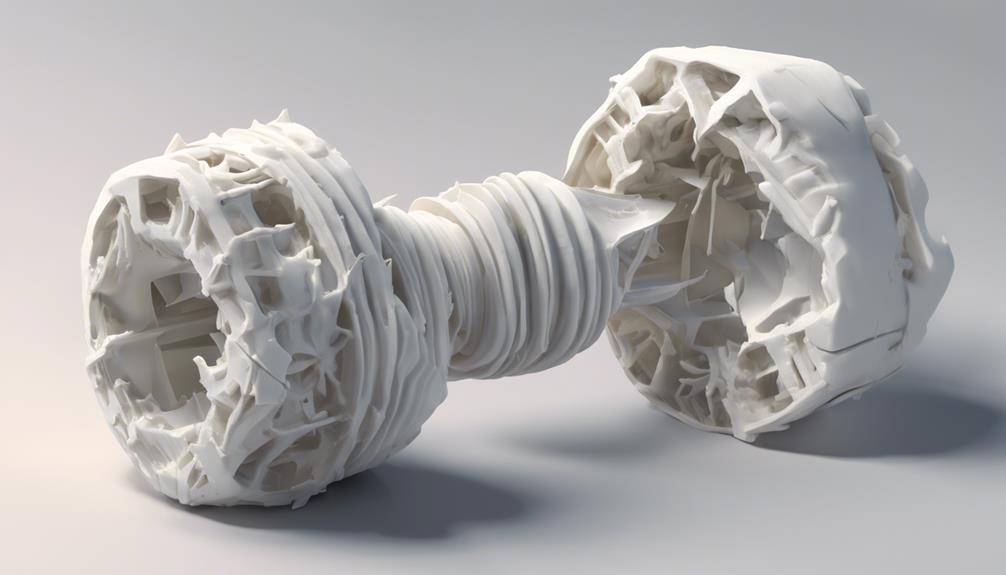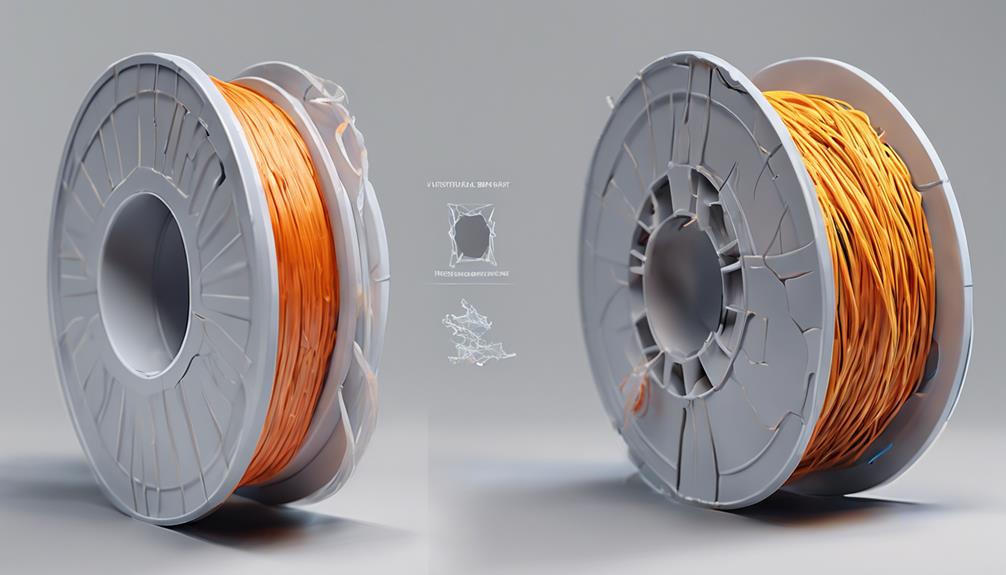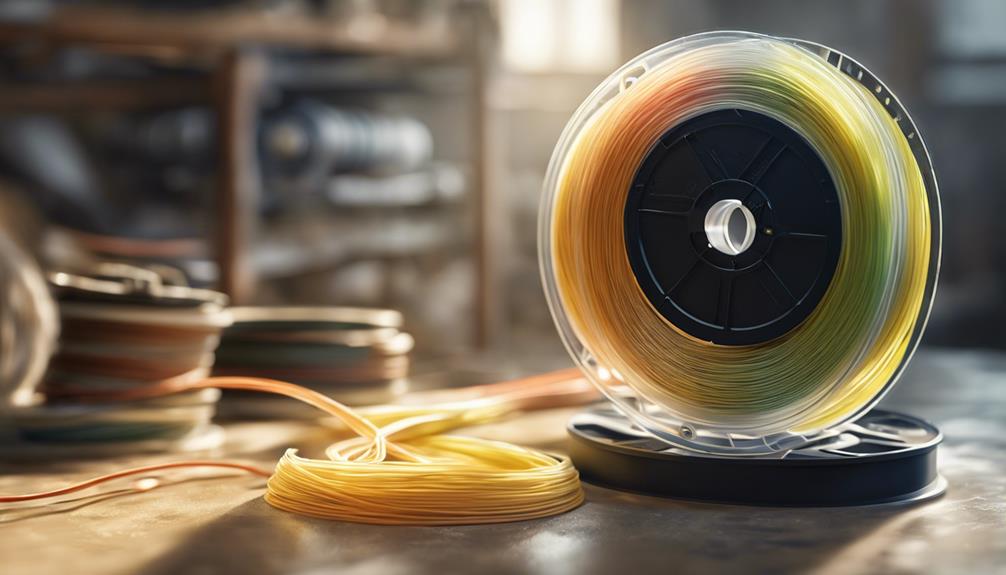When your PLA filament starts showing signs of brittleness, it can be frustrating and hinder your printing projects. Understanding the root causes behind this issue is vital to guarantee smooth printing processes and high-quality outcomes. By uncovering the factors contributing to brittleness and exploring effective solutions, you can tackle this challenge head-on and elevate your 3D printing experience.
Brittleness Causes: Mechanical, Moisture, UV, Quality

When pondering the causes of PLA filament brittleness, factors such as mechanical structure, moisture absorption, UV exposure, and manufacturing quality play pivotal roles.
Your filament's natural mechanical structure contributes to its inherent brittleness, making it prone to snapping under stress.
Moisture absorption from the environment can further exacerbate this brittleness, leading to issues like filament jamming and snapping during printing.
Exposure to UV rays can also weaken the filament, causing it to become brittle and fragile over time.
Additionally, variations in manufacturing quality can impact the brittleness of the filament, as inferior ingredients or processes may result in a lower-quality product that's more prone to breakage.
It's crucial to take into account these factors to maintain the quality and longevity of your PLA filament.
Moisture Absorption: Hygroscopic Nature and Effects
To better understand the impact of moisture absorption on PLA filament brittleness, consider its hygroscopic nature and the subsequent effects it has on printing quality.
PLA is hygroscopic, meaning it absorbs moisture from the air. This moisture absorption can lead to swelling in the filament, causing potential printing issues like jamming or snapping during the printing process.
The presence of steam bubbles due to water content can also affect print consistency negatively.
To prevent these issues, it's essential to store PLA filament properly in a dry environment to avoid moisture absorption. Proper storage methods can help maintain the integrity of the filament, ensuring better printing results and reducing the risk of brittleness.
UV Light Exposure Impact on PLA

Exposure to UV rays can greatly weaken PLA filament, making it more susceptible to brittleness and breakage. When PLA is exposed to sunlight, the UV light can cause the filament to become brittle and lose its strength.
Direct sunlight exposure not only weakens the PLA but can also lead to color deterioration. This weakened filament is more likely to snap during printing or handling.
To avoid this, it's essential to store PLA filament away from direct sunlight. Keeping the filament in sealed containers with moisture absorbents can help protect it from UV light exposure and maintain its integrity.
Proper storage practices play a significant role in preserving the quality and longevity of PLA filament.
Quality Filament Considerations and Impacts
Quality filament considerations impact the durability and performance of your PLA prints. When choosing filament, not all manufacturers meet the same standards, potentially leading to brittleness in your prints. Inferior ingredients or processes, as well as color dyes and packaging issues, can all affect the fragility of the filament.
Strict storage measures are vital for maintaining the quality of biodegradable filaments. Opting for a reliable brand guarantees a higher likelihood of receiving filament that meets your standards. By prioritizing quality in your filament selection, you can enhance the overall printing experience and the longevity of your PLA prints.
Printing and Storage Recommendations for PLA

Consider implementing proper storage techniques to maintain the quality and longevity of your PLA filament.
Store your filament in a cool, dry place away from direct sunlight to prevent moisture absorption and UV damage. Use sealed containers with desiccants or vacuum-sealed bags to protect against humidity.
Keep your filament spools in their original packaging when not in use to shield them from dust and moisture. When printing, guarantee your filament is free from moisture by drying it in a filament dryer if needed.
Additionally, store your filament upright to prevent tangling and guarantee smooth feeding during printing.
Frequently Asked Questions
How Can I Prevent PLA Filament From Becoming Brittle During Storage?
To prevent PLA filament from becoming brittle during storage, keep it away from moisture and sunlight. Use sealed containers with absorbents, choose quality brands, and guarantee proper storage conditions. These steps will maintain filament integrity.
What Are the Most Common Signs of Moisture Absorption in PLA Filament?
If moisture seeps into your PLA filament, watch for signs like swelling, print issues, snapping, and inconsistent prints. Avoid direct sunlight exposure, store properly, and consider sealed containers with moisture absorbents to preserve filament quality.
Does the Color of the PLA Filament Affect Its Brittleness?
Color does not directly impact PLA filament brittleness. The filament's composition, exposure to UV rays, and moisture absorption primarily influence its fragility. Guarantee proper storage and quality filament selection to maintain ideal printing conditions.
Can Exposure to UV Light Impact the Flexibility of PLA Filament?
Exposure to UV light can make PLA filament brittle, affecting flexibility. Store it away from direct sunlight. Moisture absorption worsens brittleness; prevent it with proper storage. Use quality filament to avoid fragility issues.
Are There Any Specific Brands Known for Producing Less Brittle PLA Filament?
When selecting PLA filament, opt for reputable brands like Brand A and Brand B, recognized for producing less brittle filaments. These brands prioritize quality manufacturing processes, enhancing the filament's durability and reducing the risk of brittleness.
Conclusion
You've learned the causes of PLA filament brittleness and how to combat them. Remember, keep your filament dry, shielded from UV light, and choose top-notch options for best printing results.
With these simple steps, you'll be printing like a pro in no time, leaving brittle filaments in the dust!